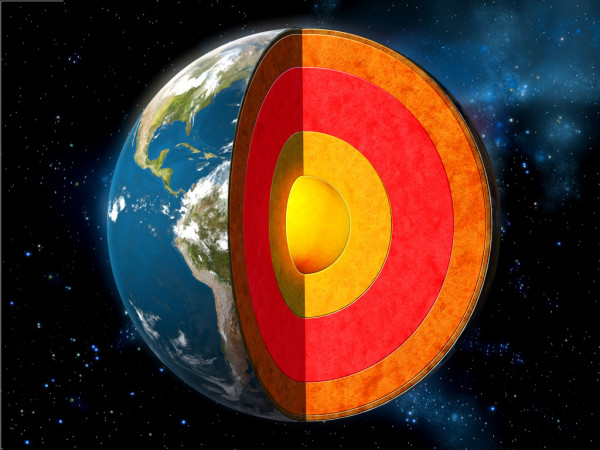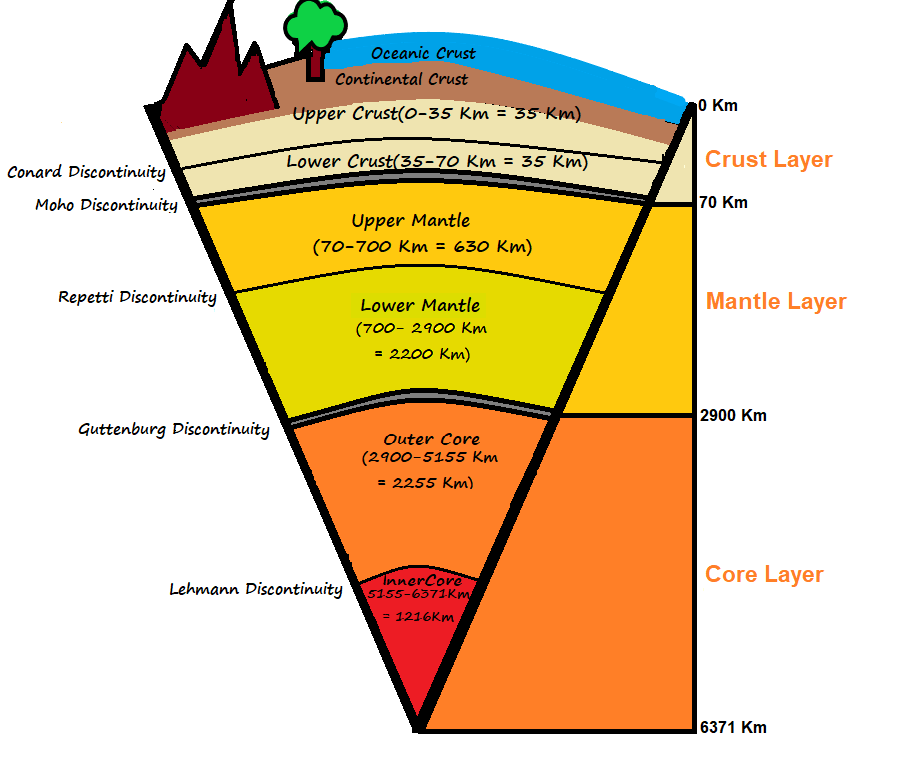
In this article, we will learn about the different Layers of the Earth and some other facts about the inner part of the Earth.
As we know Earth is a moving planet and For this reason, the interior and exterior part of the earth changes from time to time.
Have you ever thought about what is in the interior of the Earth? and what materials it is made of? If you don’t know the answer to this question, in this article you will understand the answer to this question very well.
Our Earth is like an onion. Just as onions have many layers, in the same way the Earth is also made up of many layers. Chemically, we can divide the Layer of the Earth into three parts -
- The Crust
- The Mantle
- The Core
Now we will learn about the facts of the Layers of the Earth one by one.

The Crust
- The Crust of the Earth is the outermost layer of the Earth.
- The Crust is the thinnest layer of the Earth.
- The crust is the coldest layer because it is exposed to the atmosphere.
- The Crust is only 1% of the Earth’s volume.
- The Crust of the Earth made of solid rocks.
- The Crust is the visible part of the Earth that we can see.
- The Crust of the Earth is made up of three types of rocks: Igneous, Metamorphic, and Sedimentary rocks.
- The Crust of the Earth can be divided into two parts: Oceanic crust and Continental crust.
- Oceanic crust is thinner than continental crust. Oceanic Crust may be 5 to 10 kilometers thick and Continental Crust may be 30 to 70 kilometers thick.
- The temperature of the crust is 200 degrees Celsius (392 Fahrenheit) to 400 degrees Celsius (752 Fahrenheit).
- Continental crust mainly consists of minerals like Silica and Alumina. It is called Sial.
- Ocean crust mainly consists of Silica and Magnesium. It is called Sima.
- Continental crust and Oceanic crust both are less dense than the below-layer Mantle, so both types of crust "float" on the Mantle.
- The most abundant element in the Earth’s crust is oxygen then silicon, aluminum, iron, and calcium.
- The boundary area between the upper crust and lower crust is called Conrad Discontinuity.
- The uppermost mantle layer together with the crust forms the lithosphere.
Moho Discontinuity
The Mohorovicic discontinuity or Moho Discontinuity is the boundary between the crust and the mantle.
The Mantle
- The Mantle of the Earth is the thickest layer of the Earth.
- The thickness of the mantle of the Earth is 2900 km.
- The mantle of the Earth is divided into two layers: the Upper mantle and the Lower mantle.
- The depth of the Upper mantle is 700 km, and the depth of the Lower mantle is 700 km up to 2900 km.
- The boundary between the upper mantle and the lower mantle is called Repetti Discontinuity.
- It is composed of silicate minerals. It consists of more magnesium and iron and less silicon and aluminum than the crust.
- 84% of Earth’s volume is the Mantle layer.
- The temperature of the mantle is 1000° C (1832° F) near its boundary with the crust and 3700° C (6692° F) near its boundary with the outer core.
Gutenberg Discontinuity
The boundary between the lower mantle and the upper core is called the Gutenberg Discontinuity.
The Core
- The center of the earth is called the Core.
- The core of the Earth is 15% of the Earth’s volume.
- The core of the Earth is made of nickel and ferrous. It is called Nife.
- The core of the Earth is divided into two parts: The inner core and the Outer core.
- The outer core is about 2,200 km thick and is mostly composed of liquid iron and nickel.
- The inner core of the Earth is about 1,220 km thick.
- The inner core remains in solid form and the outer core remains in liquid form.
- The boundary between the outer core and the inner core is called Lehmann-Discontinuity.
- The inner core is the hottest part of the Earth.
- The temperature of the outer core of the Earth remains between 4,500° and 5,500° C (8,132° and 9,932° F), and the temperature of the inner core of the Earth remains between 5,200° and 7,000° C (9,000 and 13,000° F).
- The inner core of the Earth is as hot as the surface of the sun. Even with such heat, the metal present there does not melt because the pressure is too high there.
Layer of the Earth FAQs
- Which layer of the earth is the thickest?
The Core layer is the thickest layer of the Earth. It is about 3471 Km thick whereas the Crust layer is 70 Km thick and the Mantle layer is near about 2830 Km thick.
- How thick is the crust of the earth?
The Crust of the Earth is about 70 Km thick.
- What is the crust of the earth made of?
The crust of the Earth is made up of several elements such as oxygen - 46.6 %, silicon 27.7 %, aluminium 8.1 %, iron 5 %, calcium 3.6 %, sodium 2.8 %, potassium 2.6 %, and magnesium 2.1 %.
- How deep is the crust of the earth?
The crust of the Earth is about 70 Km deep.
- What is the crust of the earth?
The Crust is the Outermost layer of the Earth.
- What is the core of the earth made of?
The Core of the Earth is made of Nickel and Furious.
- Is the inner core solid or liquid?
The inner core of the Earth is very hot but because of high pressure, it is in solid form whereas the outer core layer is in liquid form.
- What is the hottest layer of the earth?
The inner core of the Earth is the hottest layer. It is as hot as the surface of the Earth. The temperature of this layer is about 5,200°C - 7,000°C.
- Which layer of the earth is liquid?
The outer core of the Earth is in liquid form as it is made of nickel, iron, and molten rock.
- What is the outermost layer of the earth?
The crust is the outermost layer of the Earth. It is about 70 km thick. It further categorized into two-layer i.e. Upper crust and Lower crust.
|
Read this also

